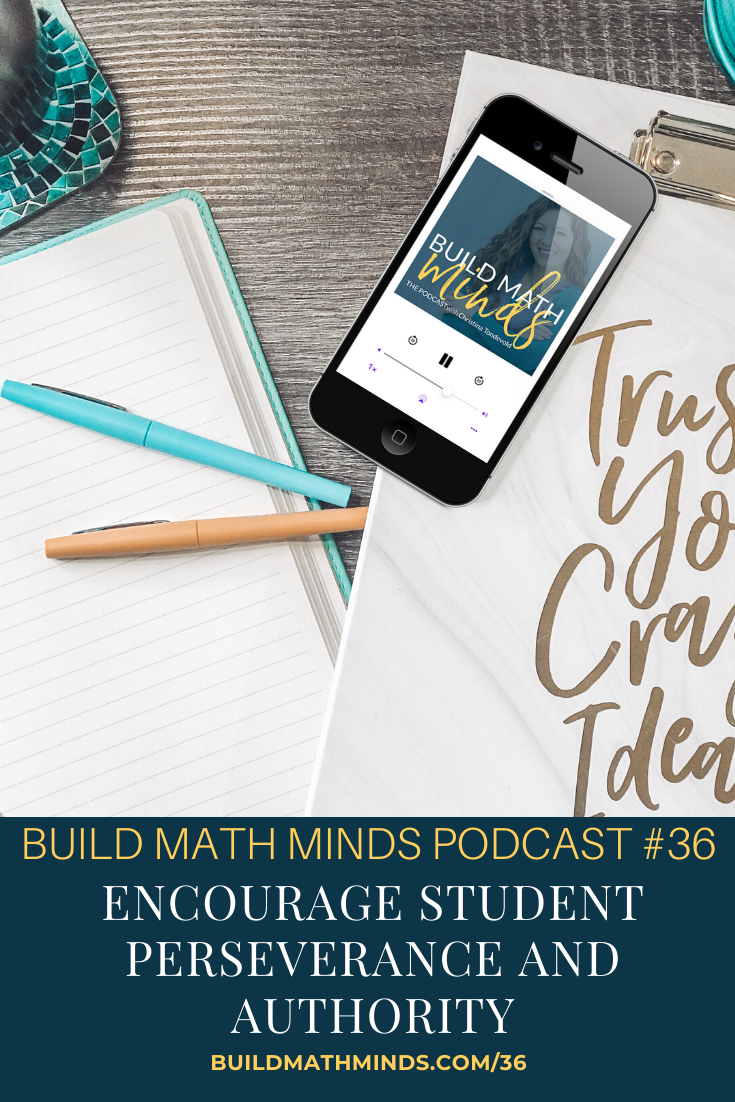Resources mentioned in this episode:
Two Instructional Moves to Promote Student Competence by Jen Munson
Changing the way we teach mathematics is hard for us as teachers, but sometimes it’s even harder on our students. If you’ve tried to open up your teaching and give students a problem and then just let them solve it anyway they can, then I’m sure you’ve had that feeling that the idea of Productive Struggle sometimes doesn’t seem so productive.
So, today I wanted to share with you an article that you can read on the National Council of Teachers of Mathematics’ website. NCTM publishes a great magazine throughout the year, full of wonderful articles. The article Two Instructional Moves to Promote Student Competence by Jen Munson is from the January 2018 issue. The article is a really short read, like only 3 pages, that showcases how to help students learn to persevere and have more authority over their learning through the lens of a teacher, Mrs. Hobbs, who is trying to do that with her 4th graders. On page 246, Jen writes:
“Struggle remains productive only if students have the conceptual tools, mathematical practices, disposition, and intellectual community to support them (Bass and Ball 2015; Hiebert and Grouws 2007). As teachers like Hobbs transition from teaching students to avoid struggle to encouraging it, students are particularly vulnerable (Lampert 2001). They might not yet believe that struggle can be productive. Their identities as math learners are being disrupted. And the mathematical practices that help learners navigate struggle are very much under construction (compare Makar, Bakker, and Ben-Zvi 2015). So, what should Hobbs do to support her students? Teachers can use moves to position students with competence (Cohen et al. 1999; Gresal et al. 2009). These moves imply publicly that a particular student is competent to tackle the task at hand and has the intellectual authority to do so. Such moves have been shown to have a meaningful impact on long-term student learning, as they not only boost a student’s immediate engagement in the task but also shape a student’s identity as a learner. Such instructional moves have a differential impact on the learning outcomes of those most marginalized as math learners, making positioning moves an important tool for equity (Langer-Osuna and Esmonde 2017; Turner et al. 2013). Over time, students come to see themselves as powerful agents, capable of driving their own learning through the use of mathematical practices such as critique, argumentation, and persistence.”
The rest of the article goes into a couple teacher moves Mrs. Hobbs uses. Now as I said the article is really short so I’m going to be mean and not even tell you what those moves are. I want you to go read them for yourself. But I will tell you one more line from the article that I just loved:
“She does not simply assert confidence (e.g., “You can do it!”) and walk away, leaving them stuck or hesitant. She expresses through these moves her belief that her students can find their own way, and she literally stands by them as they think, searching for words or ideas. She then affirms their ideas as worth trying, and only then does she leave.”
That line struck me, because I can recall so many times saying that exact thing. “You can do it!” and then moving on to the next group. So if you are like me and need a few more teacher moves to help out those kiddos as they are working on productively struggling, go read this article.
Subscribe and Review in iTunes
While you’re there, don’t forget to leave a review on iTunes too. I would love to know your thoughts and how we can make sure that we give you content that you will really enjoy.
To leave a review, head over to iTunes and click on “Ratings and Reviews” and “Write a Review.” I can’t wait to hear your thoughts about the podcast.





Your work, not only podcasts, have inspired me so much. I retired in December last year, and I cannot get a job back in South Africa, but hang onto every amazing mail I’ve received from you. I am sharing ideas with all my teacher friends, and parents who I meet. Is all just makes so much sense and I wish I’d had them while I was teaching. I have to say that so much of what you’re sharing has been how I’ve tried to encourage my students to do since ‘meeting’ Marilyn Burns’ work in 2001. And lately, since ‘meeting’ Jo Boaler reading her Mindset stuff, you have become my super herione in putting it all together as you have. As a grandma now, I use your ideas to encourage my grandchildren and their friends when they tell me how they are battling with math. Fun stuff gets them hooked! Hopefully I can share with more and more kids, their parents and my younger teacher friends for many years to come. Thank you SO much for your amazing work, and especially for sharing it with all of us.
Let’s build a lesson plan that works for this type of podcast.